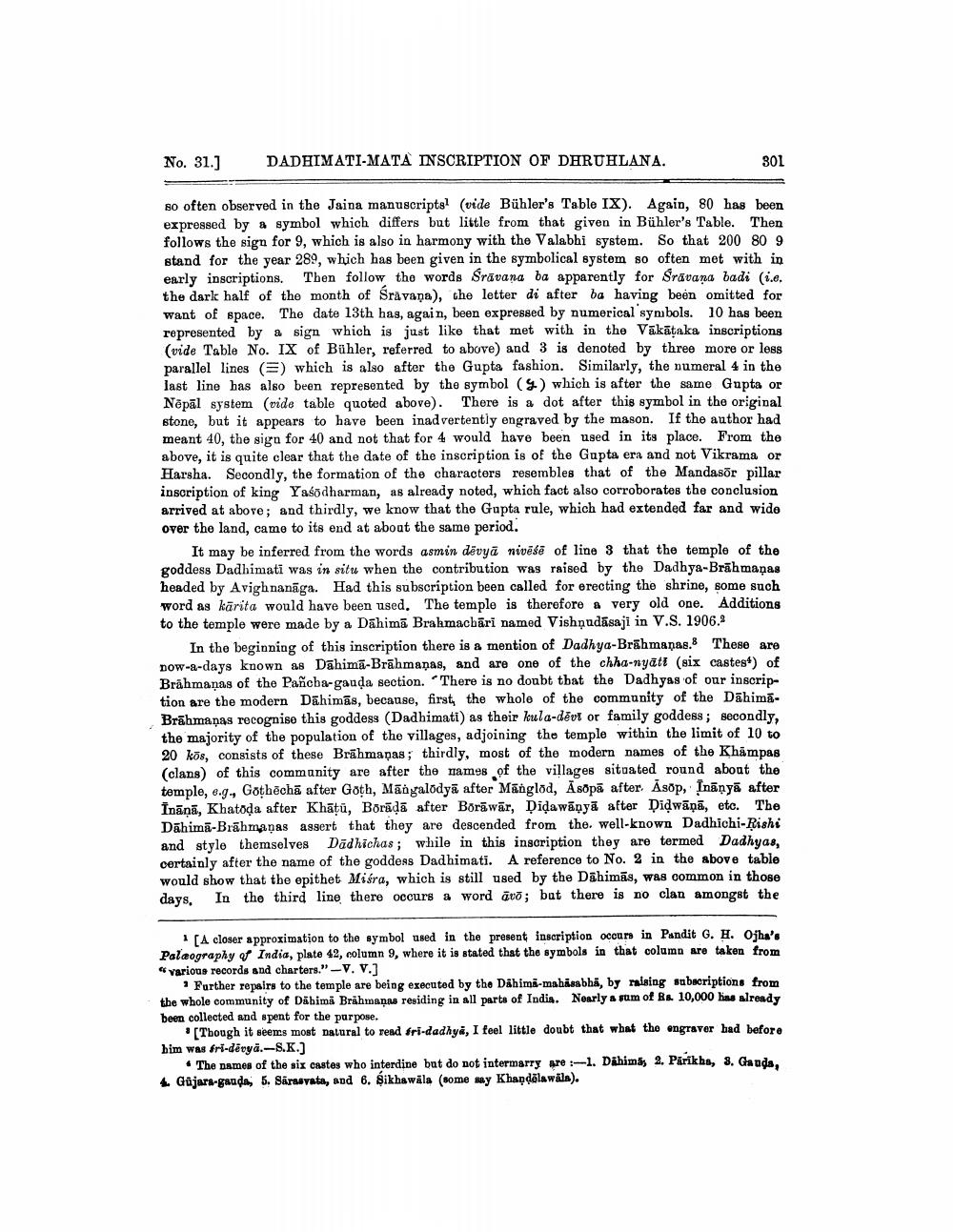________________
No. 31.]
DADHIMATI-MATA INSCRIPTION OF DHRUHLANA.
801
so often observed in the Jaina manuscripts (vide Bühler's Table IX). Again, 80 has been expressed by a symbol which differs but little from that given in Bühler's Table. Then follows the sign for 9, which is also in harmony with the Valabhi system. So that 200 80 9 stand for the year 289, which has been given in the symbolical system so often met with in early inscriptions. Then follow the words Srāvana ba apparently for Sravana badi (i.e. the dark half of the month of Sravana), the letter di after ba having been omitted for want of space. The date 13th has, again, been expressed by numerical symbols. 10 has been represented by a sign which is just like that met with in the Vākātaka inscriptions (vide Table No. IX of Bühler, referred to above) and 3 is denoted by three more or less parallel lines (E) which is also after the Gupta fashion. Similarly, the numeral 4 in the last line has also been represented by the symbol (4) which is after the same Gupta or Nēpāl system (vide table quoted above). There is a dot after this symbol in the original stone, but it appears to have been inadvertently engraved by the mason. If the author had meant 40, the sign for 40 and not that for 4 would have been used in its place. From the above, it is quite clear that the date of the inscription is of the Gupta era and not Vikrama or Harsha. Secondly, the formation of the characters resembles that of the Mandasor pillar inscription of king Yasodharman, as already noted, which fact also corroborates the conclusion arrived at above; and thirdly, we know that the Gupta rule, which had extended far and wide over the land, came to its end at about the same period.
It may be inferred from the words asmin dëvyā nivēša of line 3 that the temple of the goddess Dadhimati was in situ when the contribution was raised by the Dadhya-Brāhmaṇas headed by Avighnanāga. Had this subscription been called for erecting the shrine, some such word as kārita would have been used. The temple is therefore a very old one. Additions to the temple were made by a Dāhima Brahmacbāri named Vishnudāsaji in V.S. 1906.9
In the beginning of this inscription there is a mention of Dadhya-Brahmanas. These are now-a-days known as Dāhimā-Brāhmaṇas, and are one of the chha-nyatt (six castest) of Brāhmaṇas of the Pañcba-ganda section. There is no doubt that the Dadhyas of our inscription are the modern Dāhimās, because, first, the whole of the community of the DāhimăBrāhmaṇas recognise this goddess (Dadhimati) as their kula-dēvt or family goddess; secondly, the majority of the population of the villages, adjoining the temple within the limit of 10 to 20 kos, consists of these Brāhmaṇas; thirdly, most of the modern names of the Khampas (clans) of this community are after the names of the villages situated round about the temple, e.g., Gothēchă after Goth, Māngalodyā after Mānglod, Asopā after. Asop, Ināṇyā after Ināņā, Khatoda after Khāțū, Borādā after Borāwār, Didawāṇyā after Didwāņā, etc. The Dāhima-Brāhmaṇas assert that they are descended from the well-known Dadhichi-Rishi and style themselves Dadhichas; while in this inscription they are termed Dadhyas, certainly after the name of the goddess Dadhimati. A reference to No. 2 in the above table would show that the epithet Misra, which is still used by the Dahimās, was common in those days. In the third line there occurs a word ard; but there is no clan amongst the
[A closer approximation to the symbol used in the present inscription occur in Pandit G. H. Ojha's Palaography of India, plate 42, column 9, where it is stated that the symbols in that column are taken from “various records and charters." -V. V.]
* Further repairs to the temple are being executed by the Dähima-mabisabbá, by raising sabscriptions from the whole community of Dabimi Brahmaņas residing in all parts of Indis. Nearly a sum of Rs. 10,000 has already been collected and spent for the parpose.
[Though it seems most natural to read fri-dadhya, I feel little doubt that what the engraver had before him was fri-dérya.-S.K.)
• The names of the six castes who interdine but do not intermarry re-1. Dahimas 2. Parikhs, 8. Gauda, Gujara-gauda, 5. Säravata, and 6. sikhawala (some say Kha dolawala).




